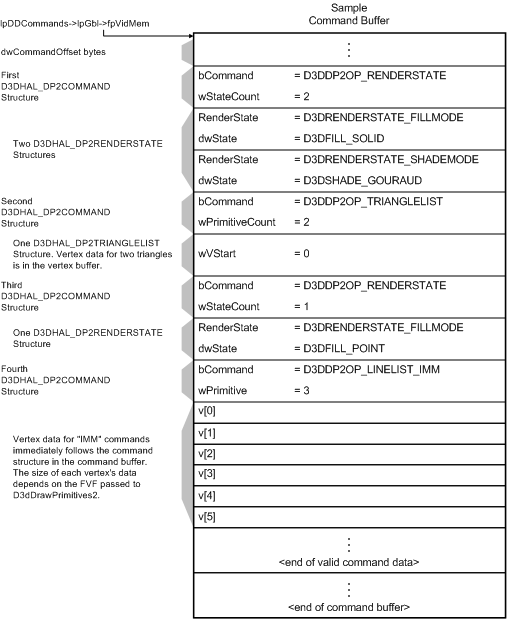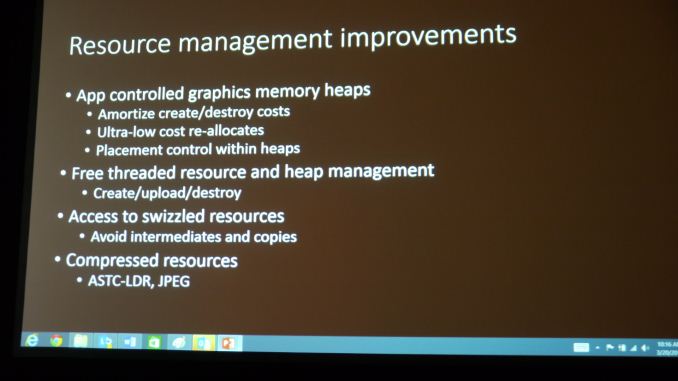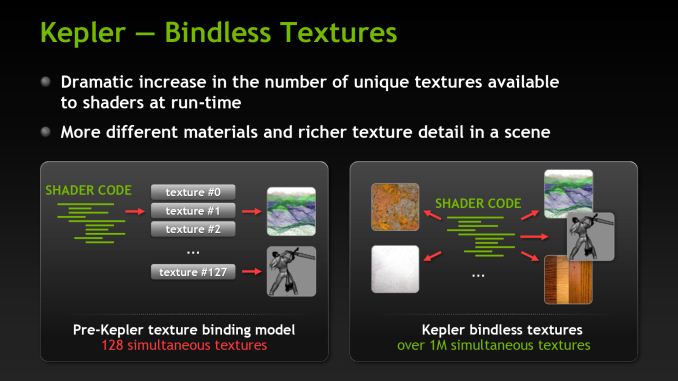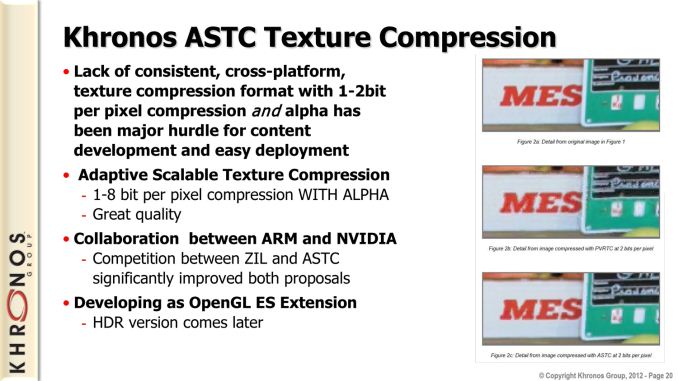Microsoft Announces DirectX 12: Low Level Graphics Programming Comes To DirectX
by Ryan Smith on March 24, 2014 8:00 AM ESTDirect3D 12 In Depth
This brings us to Direct3D 12, which is Microsoft’s entry into the world of low level graphics programming. Microsoft is still neck-deep in development of Direct3D 12 so far – they’re currently targeting it for game releases in Holiday 2015, roughly 18 months off – and as such Microsoft hasn’t released a ton of details about the API to the public yet. But they have given us a broad overview of what the plan to accomplish, with a couple of technical details on how they will be doing this.
At a high level there is no denying the fact that Direct3D 12 looks a lot like Mantle. Microsoft has set out with the same basic goals as AMD did with Mantle and looks to be achieving some of them in the same manner. Which to no surprise then that the end products are going to be similar as a result.
As with Mantle, the primary goal for Direct3D 12 is to greatly reduce the CPU overhead that we’ve talked about previously. As the biggest source of CPU overhead is having Direct3D assemble the command lists/buffers for a GPU, Direct3D 12 will be moving that job over to developers. By assembling their own command lists developers can more easily spread out the task over multiple cores, and this alone will have a significant impact on CPU utilization. At this point we don’t know what Direct3D 12 command lists will look like, and this will likely be one of the design choices that separates Direct3D 12 from Mantle, but there’s no reason at this time to expect them to be much different.

For Comparison: D3D11 Command Buffer
Microsoft will also be introducing a similar concept, a bundle, which is functionally a form of a reusable command list. This again is another CPU saving step, as using a bundle in place of multiple command lists further cuts down on the amount of CPU time spent making submissions. In this case the idea behind a bundle is to submit work once, and then allow the bundle to be executed multiple times with minor variations. Microsoft specifically notes having a character drawn twice with different textures as being a use case for this structure.
Meanwhile it’s interesting to note that with this change Microsoft has admitted that Direct3D 11 style immediate/deferred command lists haven’t lived up to their goals, stating “deferred contexts also do not map perfectly to hardware, and so relatively little work can be done in them.” To our knowledge the only game able to make significant use of the feature was Civilization V, and even then we’ve seen AMD video cards perform very well without supporting the feature.
Moving on, Direct3D 12 will also be introducing pipeline state objects. With pipeline state objects we’re really getting into the nitty-gritty of command buffer execution and how the various graphics architectures differ, but the important bit to take away is that most architectures don’t have the ability to freely transition between pipeline states as much as Direct3D 11 would like. This leads to problems for how quickly the hardware state can be set, as Direct3D must go back and take into account these hardware limitations.
The solution to this will be the aforementioned pipeline state objects (PSOs). PSOs bypass some of these pipeline limitations by using objects that are finalized on creation. Nitty-gritty details aside, the outcome from this is that it further reduces CPU overhead, once again increasing the number of draw calls the CPU can submit or freeing it up for other tasks.
The final major addition to Direct3D 12 is descriptor heaps. Going back to 2012, one of the features introduced on NVIDIA’s then-new Kepler architecture was bindless resources, which bypassed the previous 128 slot limitation on resources (textures, etc). Through bindless an essentially infinite number of resources could be addressed, at a performance penalty, though an additional layer of indirection in memory accesses.
Descriptor heaps in turn appear to be the integration of bindless resources in Direct3D 12. Microsoft does not specifically call descriptor heaps bindless, but the description of slots and draw calls makes it clear that they’re intending to solve the problem with the bindless solution. With descriptor heaps and descriptor tables to reside in those heaps, Direct3D 12 will be able to perform bindless operations, both expanding the number of resources available to shader programs, and even outright dynamic indexing of resources.
Finally, there are a few miscellaneous features that have popped up in Microsoft’s slides that have caught our attention, if only due to the lack of details provided. Specifically, the mention of compressed resources stands out. The resources mentioned, ASTC and JPEG, are not resources formats that we know to be supported on any current PC GPU. In the case of ASTC, Khronos’s next generation texture compression format, it is a finalized standard that will be supported on all GPUs in time as a core part of the OpenGL standard. Meanwhile JPEG is not a feature we’ve seen on any API roadmaps before.

Image Courtesy PC Perspective
To that end, the addition of ASTC is not all that surprising. Since it is royalty free and not otherwise restricted to OpenGL-only, there’s no reason not to support it when all of the underlying hardware will (eventually) support it anyhow.
JPEG on the other hand is a very curious thing to mention, as its lack of existence on any API roadmaps goes along with the fact that we’re not aware of anyone having announced plans to support JPEG in hardware. Furthermore JPEG is not a fixed ratio compressor – the number of bits a given sized input will generate can vary – which for GPUs would typically be a bad thing. It stands to reason then that Microsoft knows a bit more about what features are in the R&D pipelines for the GPU makers, and that someone will be implementing hardware JPEG support. So we’ll have to keep an eye on this and see what pops up.
Making a Common Low Level API
The need for a low level graphics API like Direct3D 12 is clear, but establishing a common API is no easy task. Abstraction is both what gives Direct3D 11 its ability to work on multiple platforms and robs Direct3D 11 of some of its performance. So to make a low level API that works across AMD, NVIDIA, Intel, Qualcomm, and others’ GPUs requires a careful balancing act to bring low level API improvements while adding no more abstraction than is necessary.
At this stage in development Microsoft is not ready to talk about that aspect of API development; for the moment that level of access is restricted to a small group of approved developers. But given their hardware requirements we can make a few educated guesses about what’s going on behind the scenes.
Of the big 3 GPU vendors, all of them have confirmed what GPUs will be supported. For Intel their Gen 7.5 GPUs (Haswell generation) will support Direct3D 12. As for NVIDIA, Fermi, Kepler, and Maxwell will support Direct3D 12. And for AMD, GCN 1.0 and GCN 1.1 will support Direct3D 12.
| Direct3D 12 Confirmed Supported GPUs | |||
| AMD |
GCN 1.0 (Radeon 7000/8000/200) GCN 1.1 (Radeon 200) |
||
| Intel | Gen 7.5 (Haswell/4th Gen Core) | ||
| NVIDIA |
Fermi (GeForce 400/500) Kepler (GeForce 600/700/800) Maxwell (GeForce 700/800) |
||
The interesting thing about all of this is what’s excluded: namely, AMD’s D3D11 VLIW5 and VLIW4 architectures. We’ve written about VLIW in comparison to GCN in great depth, and the takeaway from that is that unlike any of the other architectures here, only AMD was using a VLIW design. Every architecture has its strengths and weaknesses, and while VLIW could pack a lot of hardware in a small amount of space, the inflexible scheduling inherent to the execution model was a very big part of the reason that AMD moved to GCN, along with a number of special cases regarding pipeline and memory operations.
Now why do we bring this up? Because with GCN, Fermi, and Gen 7.5, all PC GPUs suddenly started looking a lot more alike. To be clear there are still a number of differences between these architectures, from their warp/wavefront size to how their SIMDs are organized and what they’re capable of. But the important point is that with each successive generation, driven by the flexibility required for efficient GPU computing, these architectures have become more and more alike. They’re far more similar now than they have been since even the earliest days of programmable GPUs.

Wavefront Execution Example: SIMD vs. VLIW. Not To Scale - Wavefront Size 16
Ultimately, all of this is a long-winded way of saying that a bit part of the reason that there can even be a common low level graphics API is because the hardware has homogenized to the point where less and less abstraction is necessary. On a spectrum ranging from a shared ISA (e.g. x86) to widely divergent designs, we’re nowhere near the former, but importantly we’re also nowhere near the latter. This is a subject we’re going to have to watch with great interest, because MS and the GPU vendors (through their drivers) are still going to have to introduce some level of abstraction to make everyone work together through a single common low level API. But the situation with modern hardware means that (with any luck) the additional abstraction with Direct3D 12 over something like Mantle will prove to be insignificant.
Finally, it’s worth pointing out that last week’s developments with Direct3D couldn’t be happening without a degree of political backbone, too. The problem in introducing any new graphics standard is not just technical, but in bringing together companies with differing interests and whose best interests don’t necessarily involve fast-tracking every technology proposed.
Microsoft to that end currently holds a very interesting spot in the world of PC graphics, being the maintainer of the most popular PC graphics API. And unlike the designed-by-committee OpenGL, Microsoft has some (but not complete) leverage to push new technologies through when the GPU vendors and software vendors would otherwise be at loggerheads with each other. So while Microsoft is being clear this is a joint effort between all of the involved parties, there’s still something to be said for having the influence and power to bring down changes that may not be popular with everyone.












105 Comments
View All Comments
ninjaquick - Tuesday, March 25, 2014 - link
And the second look will wind up the same way. Indipendents who can starve a little longer will probably make sure to release on the Steam Machines, but larger developers, with larger codebases and way more stuff on their minds can't just jump ship without spending way too much time on re-engineering much of their code.martixy - Monday, March 24, 2014 - link
I see a bright future for the gaming industry...On that note, does anyone happen to have a time machine? Or a ship that goes really really fast?
Rezurecta - Monday, March 24, 2014 - link
What piqued my interest is the fact that even MS uses Chrome. ;)Seriously though, posted the same on Overclock.net. Given the expected time to launch, it seems that this was only thought about because of AMD and Mantle. It is a shame that AMD paved the way and may not be a vastly supported API.
Hopefully, Nvidia and Intel accept AMD's open offer to join Mantle and we can put the control in the IHV's instead of the OS maker.
errorr - Monday, March 24, 2014 - link
MS has a lot of work to do if they want to be relevant for mobile. OpenGL ES has been largely optimized for tile-based solutions and takes into account the numerous benefits and flaws compared to desktop GPUs. Just about everything in the mobile space is created to limit memory access which is slow, narrow, and power intensive. The entire paradigm is completely different. Adreno is also VLIW which means any low-level api stuff is bound to be very hard to implement. At least it will work on Nvidia chips I guess but that is still only 10% of the market at best.errorr - Monday, March 24, 2014 - link
On another note, there was some desire to get some better understanding on mobile GPU chips in the powerVR article and the ARM Mali blog at least did the math on publicly available statements and outlined the capabilities of each "shader core".Each Mali has 1-16 shader cores (4-8 usu.). Each shader core has 1-4 Arithmetic pipes (SIMD). Each pipe has 128-bit quad-word registers. The registers can be flexibly accessed as either 2 x FP64, 4 x FP32, 8 x FP16, 2 x int64, 4 x int32, 8 x int16, or 16 x int8. There is a speed penalty for FP64 and a speed bump for FP16 etc. from the 17 FP32 FLOPS per pipeline per clock. So at max with 16 shader cores with 4 pipes per core @ 600mhz that gives a theoretical compute of 652 FP32 GFLOPS. Although it seems like a 16/2 design (T-760) will do 326 FP32 GFLOPS as the more likely.
There is also a load/store pipeline and a texture pipeline (1 textel per clock or 1/2 textel w/ trilinear filtering)
Wasn't sure where to put this but they have been sharing/implying a bunch of info on their cores publicly for a while.
lightyears - Monday, March 24, 2014 - link
Please give your opinion about following question:What about notebooks with nVidia Optimus? I have a notebook with a GTX680M dedicated graphics combined with Ivy Bridge integrated graphics. So the 680M will support DirectX12, but the Ivy Bridge dedicated probably wont.
Unfortunately those two are connected by nVidia Optimus technology. A technology that it seems is impossible to put off. I looked already in my usual BIOS but I cant get rid of it. Whether I like it or not I am forced to have Optimus.
So will Optimus automatically select the 680M for DX12 applications automatically?
Or wont it work at all. And wont the game be installed because my stupid integrated graphics card doesnt support it?
The last option would be a true shame and I would really be frsutrated. Given that I spend a lot of money on a high end notebook. And I paid a lot to have a heavy (DX12 capable) 680M in it. And I still wont be able to do DX12 altough I have a DX12 capable card...
Ryan Smith - Tuesday, March 25, 2014 - link
"What about notebooks with nVidia Optimus?"There is no reason that I'm aware of that this shouldn't work on Optimus. The Optimus shim should redirect any flagged game to the dGPU, where it will detect a D3D12 capable device and be able to use that API.
ninjaquick - Tuesday, March 25, 2014 - link
Awesome use of the word shim.lightyears - Tuesday, March 25, 2014 - link
I looked at the internet and it looks like it wont be a real problem indeed. Back in 2011 the same situation existed with DX11. Some Optimus notebooks had Sandy Bridge CPU (DX 10.1 capacle) and GTX 555 (DX 11 capable). By some people the Optimus didnt automatically detect the DX 11 capable device and they had some problem,. But after some changes in the settings they managed to get DX 11 going with the GTX 555 on the Optimus notebooks.Altough the Sandy Bridge was not DX 11 capable.So I suppose Optimus also wont be a problem this time with DX12. Good news.
Altough I truely hate Optimus. It already forbid me to use stereoscopic 3D on a supported 3DTV.
ericore - Monday, March 24, 2014 - link
"But why are we seeing so much interest in low level graphics programming on the PC? The short answer is performance, and more specifically what can be gained from returning to it."That's absolute BS.
The reason is 3 fold: 1. For Xbox One 2. To prevent surge of Linux Gaming 3. To fulfill alliance/pack with Intel and Nvidia